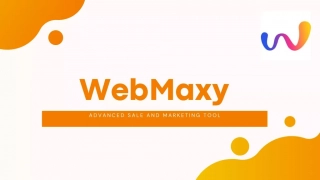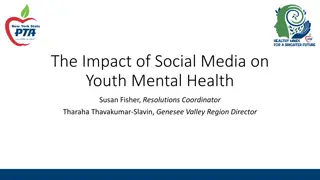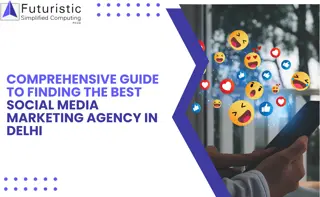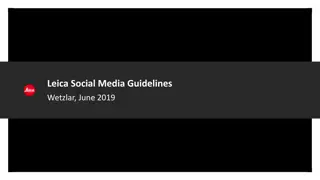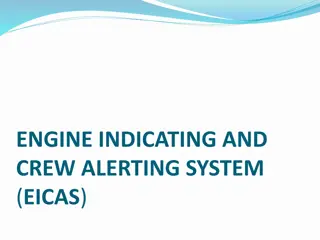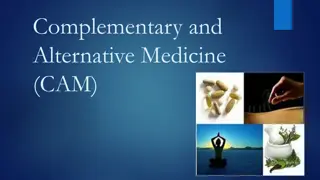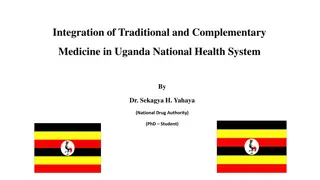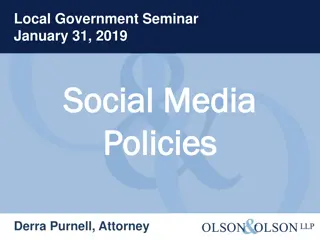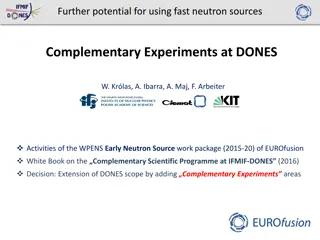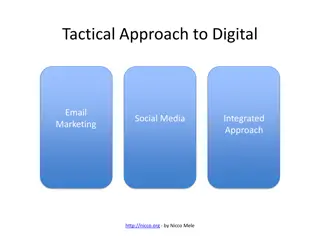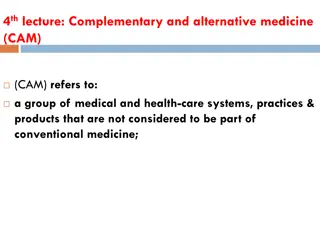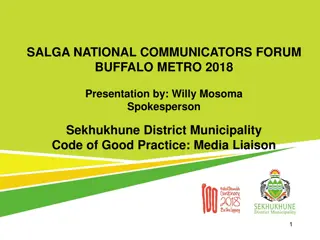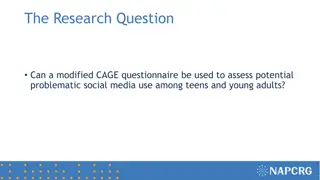Social Media & Complementary Alerting Methods: Recommended Strategies & Best Practices
This content covers a working group's recommendations on leveraging social media and complementary alerting methods for public safety outcomes. It discusses technical opportunities, barriers, and standards for coordinating alerting platforms. The group's deliverables include reports on complementary alerting systems and social media. Recent events like the Orlando Nightclub Shooting and Best Practices in over 28 areas are highlighted.
Download Presentation

Please find below an Image/Link to download the presentation.
The content on the website is provided AS IS for your information and personal use only. It may not be sold, licensed, or shared on other websites without obtaining consent from the author.If you encounter any issues during the download, it is possible that the publisher has removed the file from their server.
You are allowed to download the files provided on this website for personal or commercial use, subject to the condition that they are used lawfully. All files are the property of their respective owners.
The content on the website is provided AS IS for your information and personal use only. It may not be sold, licensed, or shared on other websites without obtaining consent from the author.
E N D
Presentation Transcript
Social Media & Complementary Alerting Methods Recommended Strategies & Best Practices Dr. Farrokh Khatibi, Co-Chair (Qualcomm) Mr. Francisco S nchez, Jr., Co-Chair (Harris County, Texas)
Working Group 2 - Roster Dr. Farrokh Khatibi Qualcomm Matthew Straeb GSS/ALERT FM Mr. Francisco Sanchez Jr. Harris Co. (TX) Emergency Management Brian Murray Harris Co. (TX) Emergency Management Hutch McClendon Advanced Computer and Communications Charity Dominguez Harris Co. (TX) Emergency Management Elizabeth T. Dexter Arlington VA OEM Tony Surma Humanitarian Toolbox Brian Daly AT&T Bob Sherry Intrado Peter Musgrove AT&T (ATIS) David Layer National Association of Broadcasters Jonathan W. Gaddy Calhoun Co. Alabama EMA Larry Walke National Association of Broadcasters Caitlin Shockey Centers for Disease Control Benjamin J. Krakauer New York City Emergency Management James Tyson Centers for Disease Control Robbie Turner Nextdoor Dara Ung Comtech Robert Bunge NOAA Dr. Keith Bhatia Comtech TCS Mike Gerber NWS Denis A. Gusty DHS, S&T/FRG Dana Golub PBS Jose Rivera DHS/OEC Mark D. Annas Riverside (CA) Fire Dept Dr. Gina M. Eosco Eastern Research Group Dr. Carol Woody Software Engineering Institute Alexander Gerdenitsch Echostar Brad Gaunt Sprint Jennifer Manner Echostar John Davis Sprint Scott Enright Emmis Communications Shelley Blakeney T-Mobile Christopher Tarantino Epicenter Media & Training Tim Dunn T-Mobile Paul Lupe Fairfax County VA OEM Amanda Faulkner Twitter Chris Anderson FCC Dr. Jeannette Sutton University of Kentucky Greg Cooke FCC Dharma Dailey University of Washington James Wiley FCC Kate Starbird University of Washington Alfred Kenyon FEMA IPAWS Amanda Hughes Utah State University Mark Lucero, CISSP FEMA IPAWS Larry Rybar Verizon Rick Wimberly Galain Solutions Xiaomei Wang Verizon 2
Objectives The Subgroup was tasked discuss and provide recommendations on technical issues such as (a) how public safety officials can leverage various platforms (including commercial alerts/social media) to best alert the public; and (b) the technical opportunities/barriers to coordinating multiple alerting platforms, as well as the development of standards that could result in improvements to public safety outcomes. 3
Deliverables Working Groups drafted recommendations in the following areas: 1. Complementary Alerting Systems 2. Social Media Final Alerting Report was submitted Friday, August 26, 2016 4
Recent Events Orlando Nightclub Shooting Miami Zika Outbreak Paris Attacks Baton Rouge Flooding Hurricane Sandy 5
Best Practices More than 28 best practices combined between social media and complementary alerting 6
Recommendation 1 Recommendation 1: Working Group 2 recommends that the use of IPAWS be expanded, through outreach and education initiatives among (a) practitioners, (b) channel proprietors, (c) organizations that support people with disabilities, limited English proficiency and older adults, and (d) alert vendors. 7
Recommendation 2 Recommendation 2: Working Group 2 recommends that the FCC, broadcasters, the wireless industry, device manufacturers and AOs support radio and TV initiatives to complement alerts. 8
Recommendation 3 Recommendation 3: Working Group 2 recommends that AOs and other entities communicate with each other as well as their stakeholders when alerts are issued. 9
Recommendation 4 Recommendation 4: Working Group 2 recommends that the FCC collaborate with ATIS, AOs, CMSPs and other stakeholders to develop internationally accepted and promoted symbols for communicating types of alerts. 10
Recommendation 5 Recommendation 5: Working Group 2 recommends that FEMA include concepts presented in this report in its agenda for the IPAWS Subcommittee to the National Advisory Council as established by the Integrated Public Alert and Warning System Modernization Act of 2015. 12
Recommendation 6 Recommendation 6: Working Group 2 recommends that FEMA publish and aggressively distribute best practices document(s) that support leverage concepts recommended. Include best practices for leveraging alerting channels in IPAWS training course (IS-247). Encourage inclusion of complementary alerting concepts in State EAS Plans. 13
Recommendation 7 Recommendation 7: Working Group 2 recommends that the FCC support FEMA s efforts to strengthen the IPAWS infrastructure. The IPAWS infrastructure should ensure a fully robust, redundant and highly available system of systems for the rapid dissemination of public information and warning in response to manmade and/or natural disasters 14
Recommendation 8 Recommendation 8: Working Group 2 recommends that local and federal public safety agencies, who are beginning to build and release their own non-WEA, public safety apps, be encouraged to develop minimally viable solutions (MVS) that are CAP compliant and integrate easily into other platforms for sharing of information. 15
Recommendation 9 Recommendation 9: Working Group 2 recommends that social media platforms be integrated into other alerting technologies. 16
Recommendation 10 Recommendation 10: Working Group 2 recommends that the FCC investigate potential improvements in the manner in which alerts are digested by complementary alerting platforms. 17
Recommendation 11 Recommendation 11: Working Group 2 recommends that the FCC and FEMA encourage alert originators, software programmers, and designers to work toward better procedural integration of emergency operation center and public information practices. 18
Recommendation 12 Recommendation 12: Working Group 2 recommends that AOs, alerting software programmers and designers gear their platforms toward a holistic messaging strategy. 19
Recommendation 13 Recommendation 13: Working Group 2 recommends that policymakers support alert generators FEMA, through EMI, should provide training and other material resources to help develop context-specific local procedures and policies. Some alerting organizations will have the capacity to build robust in-house social media use. Others will be more dependent on outside resources such as citizen volunteers and media organizations. 20
Recommendation 14 Recommendation 14: Working Group 2 recommends that key knowledge gaps be addressed through future CSRIC working groups 21
Recommendation 15 Recommendation 15: Working Group 2 recommends that the FCC coordinate with ATIS convene a panel of experts including CMSPs, FEMA, AOs, device manufacturers, the wireless industry and other WEA stakeholders to conduct a study of the impact of using social media complementary alerting techniques on commercial mobile network congestion. 22
Items for Further Discussion Social media and other channels can improve communication of emergency public information to the non-English speaking and Functional Access Needs communities. A panel of subject matter experts from the alerting community, the mass notification system developers, and others who may have expertise should be convened to identify and review best practices and technology for devising and implementing system dashboards that enable one-step alert distribution via multiple channels. 23
THANK YOU QUESTIONS? 24


